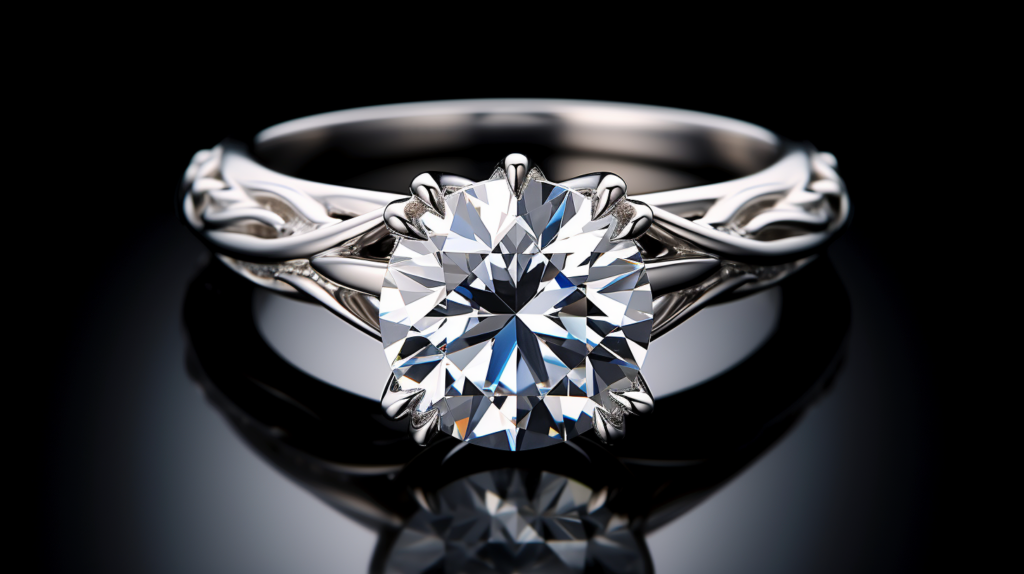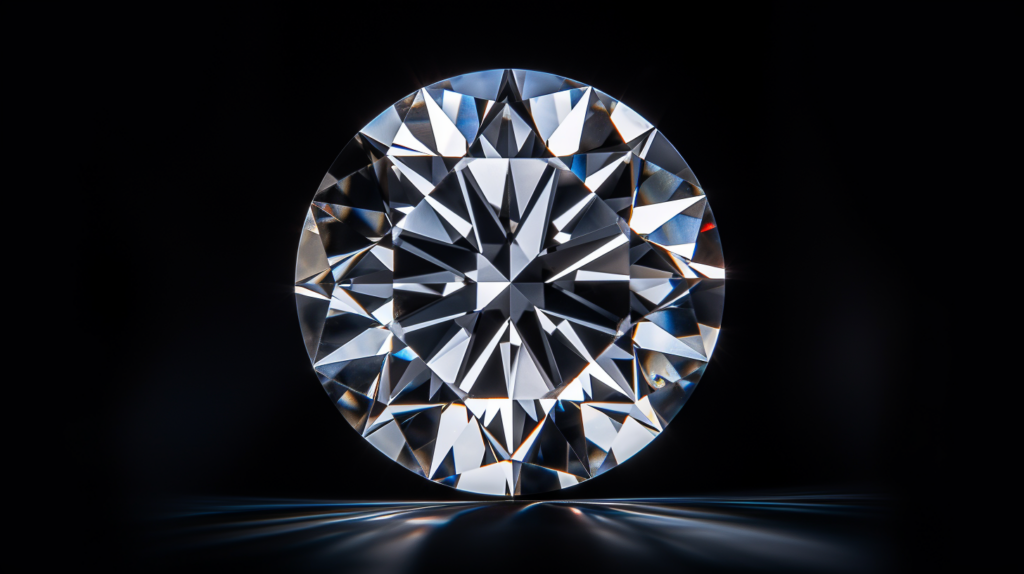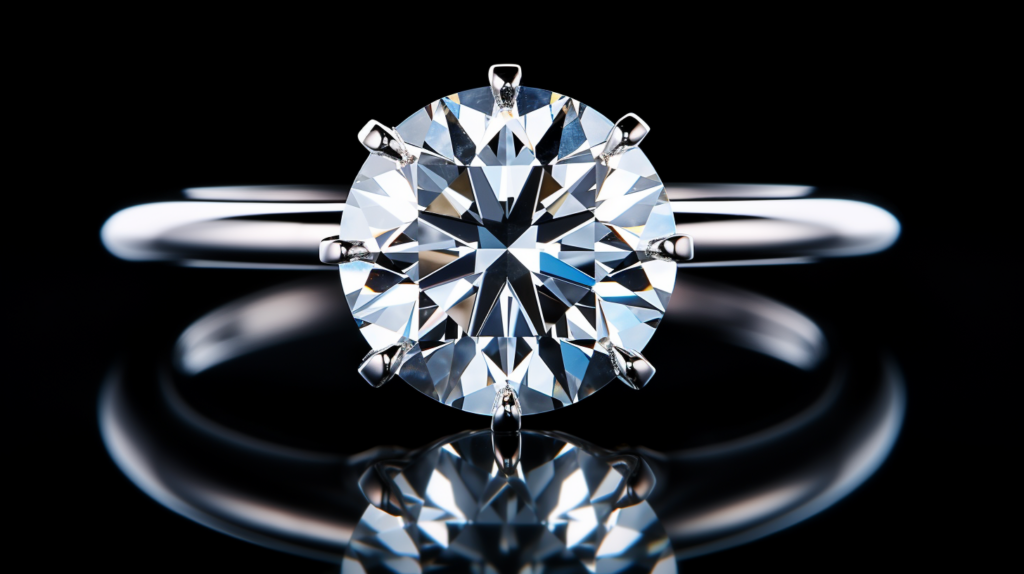Are you ready to learn a lot about SI1 clarity in diamonds? In this Brightguide article, you will learn what SI1 means and how it compares to higher clarity grades. We will help you with every step. We’ll also give you expert advice on how to evaluate and buy SI1 diamonds, so you can make a smart decision. Let’s go on this adventure together and find out how beautiful SI1 clarity diamonds are.
Key Takeaways
- SI1 clarity diamonds have slight inclusions that are visible under magnification but are often considered “eye-clean” because these flaws are not noticeable to the naked eye in normal lighting conditions.
- SI1 diamonds offer a good balance between quality and price when compared to higher clarity grades like VS. Choosing SI1 can save you money without significantly affecting the diamond’s appearance.
- To evaluate SI1 diamonds, it’s crucial to examine their clarity plots, which show the location and type of inclusions. Avoid diamonds with large, dark inclusions in the center as they can impact overall appearance.
- When buying SI1 diamonds, look for stones with small, less noticeable flaws. Consider the diamond’s shape, cut, and color grade to find the best balance between quality and value.
- The cost of SI1 diamonds varies based on factors like carat weight and cut. Trustworthy online stores like James Allen and Blue Nile provide high-quality images and tools for inspection. An in-person examination is recommended to ensure clarity.

Related article: Teardrop Engagement Rings: Discover the Elegance
In this post, we’ll explore:
Understanding SI1 Clarity Grades for Diamonds
A diamond with an SI1 clarity grade has slight inclusions, according to the clarity scale. You can see these flaws when you look closely, but many SI1 diamonds look clean to the naked eye. People say that these stones are “eye-clean,” which means that the flaws can’t be seen in normal lighting.
The diamond’s clarity grade is based on these inclusions, which can be different in terms of number, size, relief, type, and location. An ordinary jeweler’s loupe magnifies a diamond 10 times, so you can see the flaws in an SI1 diamond. On the clarity grading scale, SI diamonds typically fall toward the bottom.
Eye-clean diamonds, on the other hand, are diamonds that look clean to the naked eye and can be used for engagement rings. It is best to avoid having black crystals or big inclusions in the middle of the table, though.
Don’t miss this: Pink Diamonds: A World of Rarity and Beauty

Choosing Between SI and VS Diamonds
Diamonds with a clarity grade of SI are less included than diamonds with a clarity grade of VS. VS diamonds can be VS1 or VS2, depending on how many and how big the inclusions are. Both SI and VS diamonds are in the range where the majority of diamonds are clear and have no noticeable inclusions.
SI1 diamonds are a good mix of quality and value, and they also save you money. They are less expensive than diamonds with higher clarity grades, like VS diamonds, so they are a good choice. You might not be able to tell the difference between two eye-clean diamonds based on their clarity grade. Therefore, picking a SI1 diamond over one with a higher clarity grade can save you a lot of money without changing the way the diamond looks.
Assessing SI1 Diamonds and Their Clarity Plots
To figure out how clear a SI1 diamond is, you need to look at its clarity plot. The clarity plot shows the flaws, such as surface scratches and inclusions inside the material. The clarity plot for an SI1 diamond should show flaws. When looking at the clarity plots on SI1 diamonds, here are three important things to keep in mind:
- Where the Inclusions Are: Write down where the inclusions are on the clarity plot. It’s best to stay away from diamonds that have big flaws in the middle of the table since this can change how the stone looks overall.
- Types of Inclusions: Use the clarity plot to pay close attention to the different types of inclusions it shows. The presence of small flaws like feathers or pinpoint flaws is usually thought to be normal in SI1 diamonds.
- Visible Flaws: Think about how noticeable the flaws are overall, as shown in the clarity plot. There are some inclusions in SI1 diamonds, but many of them can still look clean to the naked eye. Look for diamonds with flaws that are spread out and either blend in with the diamond itself or are hidden by the setting. This will make the flaws less noticeable.
Don’t miss this: Orange Diamonds: What You Need to Know

How to Know If SI1 Diamonds Are the Best Deal
When compared to other clarity grades, we’ve found that SI1 clarity diamonds offer the best value. SI1 diamonds are a popular choice among diamond buyers because they strike a good balance between quality and price. Flawless diamonds are the best, but they cost a lot. On the other hand, SI2 and lower-clarity diamonds might have visible inclusions that change how the stone looks overall.
SI1 clarity diamonds are a great choice for people who want to buy loose diamonds or engagement rings. They provide an eye-clean level of clarity, which means that the flaws can’t be seen with the naked eye. This is very important for round cuts that are less than 1 carat. SI1 diamonds can look clean to the naked eye even when they are in other shapes, like oval, cushion, radiant, marquise, or pear. Buyers can now select a larger diamond without sacrificing quality.
Before we get to the next part, which has buying tips for SI1 diamonds, it’s important to think about a few things when you’re looking for the perfect diamond.
An interesting read: The Guide to Old Mine Cut Diamonds

Advice on How to Buy SI1 Diamonds
When buying a SI1 diamond, it’s important to look at it very carefully and look for small flaws that are hard to see. You can follow these tips:
How good is the diamond?
Look for diamonds that have good facet patterning and a light return. The light performance and overall brilliance of a brilliant cut diamond will be improved by a well-proportioned table facet. Check the lab report’s clarity plot for any noticeable inclusions, especially in diamonds that are 1 carat or bigger.
VS clarity
If you want a higher clarity grade VS clarity diamonds are a good choice. VS diamonds are clearer than SI diamonds because they have very few inclusions. But keep in mind that picking an SI1 diamond over a VS diamond can save you a lot of money without making a difference in how the diamond looks.
Check out the clarity plot.
By looking at the clarity plot, we can find out where and what kind of inclusions are in the diamond. This information is very important for figuring out how the diamond looks and how much it’s worth. We can choose eye-clean SI stones that give us the best value for our diamond purchase thanks to their assistance in understanding the appearance of inclusions.
Keep an eye on where the inclusions are
Let’s pay close attention to where the inclusions are to get the best deal on our SI1 diamond purchase. When looking at where the flaws are in a SI1 diamond, these three things are very important to keep in mind:
Dark Crystal Inclusions
Dark crystal inclusions, also referred to as black inclusions, can detract from a diamond’s visual appearance. These flaws stand out more and can change how bright the stone looks overall. You should stay away from diamonds that have dark crystal inclusions, which are easy to see even without a magnifying glass.
Bugs in the Diamond
Bugs that are close to the diamond’s center or on the table can be more of a problem because they can be seen with the naked eye. These things can make the diamond less clear and less beautiful overall. It is best to pick diamonds with flaws that are spread out and either blend in with the diamond itself or are hidden by the ring setting.
Think about the Color Grade
The color grade of the diamond can also change how noticeable the flaws are. People who buy diamonds with color grades like D or E are more likely to find flaws that aren’t obvious. In order to ensure a clean diamond with excellent visual appearance, it’s important to take the color grade into account when choosing a SI1 diamond.
Try to find small flaws.
When looking for a good balance between quality and value, small flaws are a great choice. The presence of these flaws is acknowledged, but they are not as noticeable as other inclusions. By picking SI1 diamonds with small flaws, you can be sure you’re getting a high-quality stone and get the most for your money. By carefully balancing these factors, you can find a diamond that looks good and is clear without spending a lot of money.
Know the Diamond Shapes
When buying SI1 diamonds, the first thing you should think about is the shape of the stone. It depends on the shape of the diamond, how well the flaws are hidden, and how it reflects light. Keep these three important things in mind:
- Brilliant Diamond Shapes: Brilliant diamond shapes like round and princess cuts are renowned for their superior light performance and capacity to conceal inclusions. If you want an eye-clean SI1 diamond, these shapes are a good bet.
- Step-Cut Diamond Shapes: Inclusions are easier to see in step-cut diamond shapes like emerald and Asscher cuts because the facets are bigger. It’s best to choose a higher clarity grade, like VS2, for these shapes to make sure they look clean.
- Other Fancy Shapes: The unique faceting patterns of other fancy shapes, such as the oval, cushion, marquise, and pear, often make it easy to hide flaws. You can get a lot for your money with SI1 diamonds in these shapes.
It is possible to find a SI1 diamond that fits your budget and looks beautiful if you think about its shape.
Check this out: The Allure of Old European Cut Diamond
How Much Does a SI1 Diamond Cost?
When we look at quality and value together, we think about how much SI1 diamonds cost and where to buy them. Here are three important things to think about:
Spectrum of Prices
SI1 diamonds are a great mix of quality and value. Different things, like carat weight, cut, color, and shape, can cause prices to vary. An attractive SI1 diamond that meets your needs can be found on a modest budget.
Trustworthy Stores
If you want to buy SI1 diamonds, you need to make sure you buy them from a trustworthy store. James Allen and Blue Nile are two of the best choices. They have a lot of GIA or AGS-graded diamonds for sale and offer high-quality pictures and tools for inspection. Both stores also have great customer service, warranties that last a lifetime, and free returns.
In-person Inspection
Even though online stores have high-tech imaging tools, you should still see the stone in person if you can. You can then judge its clarity by looking for things like white crystals or a hazy appearance that you might not be able to see in pictures. If you’re interested in Brian Gavin Signature diamonds, you can see their huge selection for yourself by going to their showroom.
Conclusion
Finally, understanding diamond clarity, especially SI1, might assist you choose a stone. A SI1 diamond may have defects, but high-quality photographs and a grade report will help you identify them and how they effect the stone’s appearance. A diamond professional can advise you on whether a SI1 diamond is ideal for you.
Remember that a good SI1 diamond can be expensive and stunning. Compared to VS2, it may save money without sacrificing beauty and brilliance. Your preferences, budget, and 4 Cs clarity value determine whether you choose a SI1 or VS2 diamond. Choosing SI1’s somewhat included beauty or VS2’s superior clarity should yield in a dazzling, eye-catching, and unique colored diamond that meets your needs.
Sources
BrighterGuide is dedicated to providing accurate and relevant information as you explore the wonderful world of diamonds and jewelry. To this end, our writers refer to primary information sources in building each article that appears on this website. These include, but are not limited to, published news articles, government portals, research papers, and more.
- Gemological Institute of America. (n.d.). Gemological Institute Of America | All About Gemstones – GIA. https://www.gia.edu/
- Learn How to Buy a Diamond with the GIA Diamond Buying Guide | 4Cs of Diamond Quality by GIA. (2022, July 22). GIA 4Cs. https://4cs.gia.edu/en-us/diamond-buying-guide/
- American Gem Trade Association. (2019, December 10). Gemstones: The American Gem Trade Association. AGTA. https://agta.org/education/gemstones/